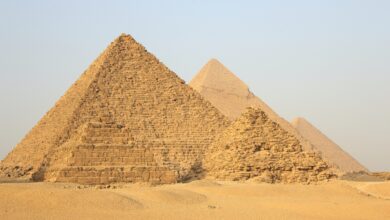News about Zahi Hawass — a clothing line, an arrest, cash rewards for the safe return of antiquities — changes daily. But before he was pinned for a shady real estate deal, Egypt’s minister of antiquities had been focusing on celebrating the revolution that has stirred up so much trouble for him by curating a 25 January exhibition.
The exhibition will feature the work of several Egyptian contemporary artists in various media in order to reflect their views on the recent revolution. The art will be accompanied by a collection of photographs showing Tahrir Square and various revolution demonstrations, and will travel the globe as Hawass’ Tutankhamen and the Pharaohs exhibition did.
“For 5,000 years Egypt was ruled, until 25 January, by a pharaoh,” Hawass told Al-Masry Al-Youm. “It is a huge change in our history, and this exhibit will present the world with the new Egypt.”
The artists will work with officials from the museums sector of the Ministry of Antiquities in order to incorporate archeological replicas into the exhibition.
The head of the sector, Mohamed Abdel Fatah, said the replicas are intended to symbolize certain important themes from ancient Egyptian history that became more prominent during the revolution – such as Ma’at, goddess of truth and justice.
A selection of clothes and flags from martyrs who died during the revolution will also be incorporated.
Though still in its embryonic stages, the exhibition is intended to start in Cairo, and travel through at least 10 European countries.
“I have already received many letters from countries — including Italy, Belgium and Spain — who are very interested to host this exhibition,” said Hawass. “It confirms my belief that the face of Egypt is changing, and people are interested to see it."
The Tutankhamen and the Pharaohs exhibition stands in stark contrast to the subject material of the 25 January exhibition — a fact that Hawass is very excited about.
“Egypt has finally broken free from the prejudice that modern Egypt is the same as ancient Egypt. When people think of Egypt now, they will no longer only be thinking about camels and pyramids. Instead they will think about democracy, freedom and how the Egyptian people really feel – so for me it was obvious that the next exhibition should show it to them.”
The exhibition is also aimed at promoting and encouraging tourism in Egypt by highlighting the appeal of modern times.
“The exhibition will also increase tourism to Egypt because not only will people come to see the pyramids and the museum, they will also come to see Tahrir Square,” Hawass said.
At the end of the European tour, the exhibition will return to Cairo and be permanently placed in the recently completed National Museum of Egyptian Civilization in Fustat. It will be the latest addition to an exhibition displaying Egypt from the beginning of its history until the present day.
“This revolution is now just as important to Egyptian history as Tutankhamen. Tahrir square is now extremely iconic of modern times in Egyptian history. To not include it would be a very poor recording of history on my part.”




